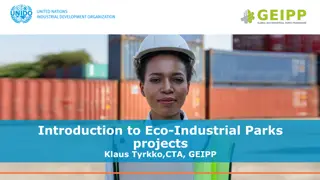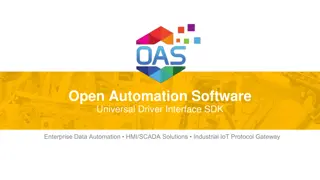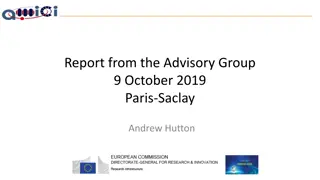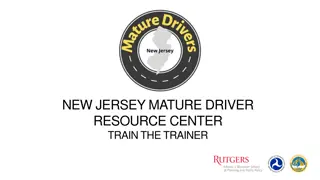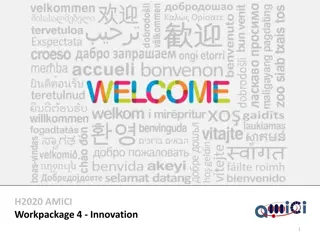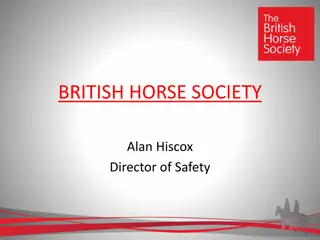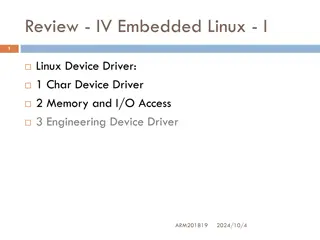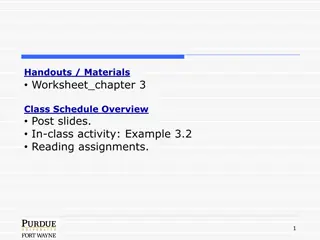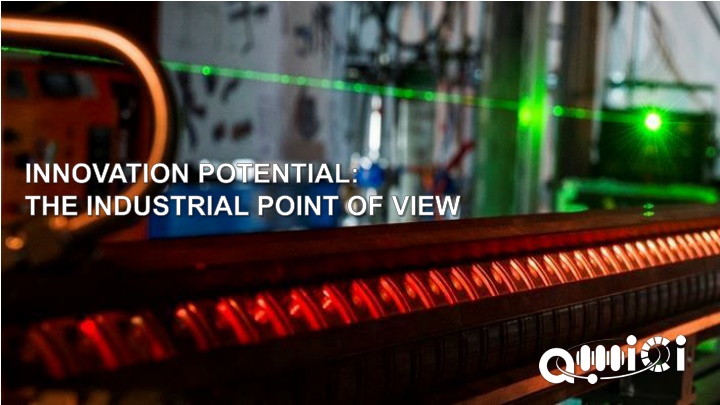
Industrial Collaboration and AMICI Drivers
Industry drivers for AMICI issues include challenges faced by companies supplying to the research infrastructure market. Barriers to entry such as cost, bureaucracy, and delayed access impact strategic innovation agendas. Collaboration outputs show more publications than patents or commercial products. AMICI key technology areas focus on particle sources, magnets, vacuum systems, and RF structures, highlighting advancements in high-energy physics research.
Download Presentation

Please find below an Image/Link to download the presentation.
The content on the website is provided AS IS for your information and personal use only. It may not be sold, licensed, or shared on other websites without obtaining consent from the author. If you encounter any issues during the download, it is possible that the publisher has removed the file from their server.
You are allowed to download the files provided on this website for personal or commercial use, subject to the condition that they are used lawfully. All files are the property of their respective owners.
The content on the website is provided AS IS for your information and personal use only. It may not be sold, licensed, or shared on other websites without obtaining consent from the author.
E N D
Presentation Transcript
INNOVATION POTENTIAL: THE INDUSTRIAL POINT OF VIEW
D4.1: Report on Accelerator Market Study Anthony Gleeson, Donna Pittaway D4.2: Report on Superconducting Magnet Market Study Pierre Vedrine, Arif Yildirim D4.3: Report on Best Practice Collaboration Between Industry and Technology Infrastructure David Alesini, Andrea Liedl
The Proposition: An Integrated Ecosystem That Will Foster Innovation Technology development, test and validation is at the epicenter of both the delivery of inspiring new European Research Infrastructures for fundamental research, and also the development of innovative products, processes and services by leading European companies to generate measurable scientific, economic and societal impact. The AMICI partnership is ideally placed to co-ordinate, promote and expand this concept, taking the building blocks and establishing an integrated ecosystem that will assist in streamlining access processes, standardizing procedures, and maximizing exploitation to realise the full innovation potential.
INDUSTRIAL COLLABORATION: CURRENT STATUS
Industry Drivers For AMICI Issues for Industry supplying into the highly cyclic Research Infrastructure market - a major challenge for companies in defining their strategic innovation agenda. Reported barriers to entry for co-innovation and access to Technical Platforms including cost, bureaucracy, delayed access and IP terms Europe perceived to be not as good as the US and Asia in translating scientific and technological discoveries into profitable products* *Evidenced by D4.3, which found the outputs from existing collaborations resulted in a high number of publications and a relatively moderate quantity of prototypes, whilst the number of patents and commercial products was very low
AMICI Drivers - Key Technology Areas AMICI Key Technology Areas AMICI Illustrative Examples Particle Sources Magnets and Vacuum Systems Ions sources, ECR, EBIS, positron sources, polarized beams Permanent & iron magnets for 4thgeneration synchrotron, FFAG, ion separators, small vacuum chambers High Tc and Nb3Sn conductors, HFM technologies, cost reduction High Field SC Magnets Normal Conducting Radio Frequency (RF) Structures RFQ & pill-box structures, high precision fabrication, RF breakdown conditioning Superconducting RF Cavities and cryomodules High Q0, high gradient, HTC materials, fabrication methods, SRF guns, robotics, cost reduction High efficiency Klystrons, continuous wave RF sources, solid state amplifiers RF Power Sources Cryogenics Beam Instrumentation High efficiency and , cryogen free cooling, cryo-safety Non-invasive and RF diagnostics, beam control systems
AMICI Key Technology Areas The KTAs during the AMICI process were principally informed by the requirements of the National Laboratories Influenced by the shorter-term requirements of the Research Infrastructures currently in development Naturally reflected in the make-up of Technical Platforms currently offered under the AMICI project. There is clear overlap in the technical requirements of both the AMICI Partners and Industry irrespective of the final specification and application. An initial step to developing a more effective European innovation ecosystem to support accelerator-related developments would be the integration of broader Industry-driven KTA requirements into the overarching development goals.
SOCIETAL APPLICATIONS: MAPPING
Industry Societal applications present a possibility to diversify markets, some of which will support considerable volumes and margins Allow businesses to more readily deal with the cyclic and irregular nature of the scientific research market. National Laboratories Regional and national funding initiatives and core funding increasingly being driven by a broader range of societal and economic metrics, in addition to scientific output. Opportunities to demonstrate innovation potential Helps to underpin a well-resourced and financially more stable Supply Chain. https://edms.cern.ch/document/1325147/2
HEALTHCARE INDUSTRIAL ENERGY SECURITY
CHALLENGES AND SOLUTIONS
Communication Challenges Sharing of knowledge and information within the particle accelerator community (academic and commercial) in Europe is poor. It relies on informal networks. Survey respondents were universally supportive of efforts to enhance coordination but many commented that the overall picture for Industry regarding use of the Technology Infrastructure was opaque . Industry cannot make use of facilities if they do not know they are available, or do not know what benefits they offer.
Communication: Portal Optimisation AMICI s shop window Use language which everyone understands, avoid the use of specialist terms where possible. Search engine optimised. To ensure effective co-ordination, time limits should be defined for responding to enquiries received through the portal. This will require assigned resource. Standard information matrix for each platform including: Detailed specification of facility and specialist expertise. Industrial contact. Access mechanism(s) for Industry: pay per day; collaborative research only; academic partner required etc. % time available for industrial use (if restricted.) Schedule of availability. Indicative cost if possible this could be in simplified terms (i.e. , , ). Publications. Patents (those developed with help from TF) to aid capture of industrial contacts through patent searches. Case study material in common AMICI format.
Communication: AMICI Promotion For National Laboratories, benefits include: Increased opportunities for co-innovation, providing solutions aligned with Key Technology Areas. Enhanced inward innovation from Industry through better knowledge of needs and strengths. Enhanced access to broader resource pool (facilities and staff) within Industry, augmenting capacity and capability. Prospect of alternative funding routes (e.g. share of national innovation programmes looking at societal applications thematic areas, often requiring commercial partners). Contribution to economic and societal impact metrics of Industry, which may be viewed favourably by regional and national funding bodies in justification of core funding. Demonstrable increase in demand for Technical Platforms ability to retain/enhance dedicated resources and improve sustainability. Development of shared training programmes and skills base with Industry. Strengthens support for academic/ commercial strategic funding bids. Standardisation of some test and validation procedures more efficient use of resources.
For the Lateral Markets and Supply Chain, benefits include: Access to advanced facilities for technology development, test and validation opens new innovation opportunities and expedites product development. Increased opportunities for co-innovation and tech transfer into the Research Infrastructure market. Heightened knowledge of available IPR, capabilities and capacity located within National Laboratories. Coordinated (ideally, integrated) access, IPR, and technology transfer policies. Transparent costing and scheduling information, allowing accurate project evaluation. Exposure to larger Supply Chain, promoting opportunities for business-to-business partnerships. Increased opportunities to develop integrated sub-systems through brokering service. Opportunity to input into development of future platforms to better reflect Industry requirements. Underpins stronger, longer-term relationships with National Laboratories. Delivered through added value, not subsidy; allowing European Industry to continue to tender internationally. For the European Science Base, the benefits include: Enhanced delivery in Key Technology Areas. Co-ordination of Technical Platforms, enhancing effective capacity, capability and expertise across existing infrastructure. Co-ordination of future Technical Platform developments providing maximum scientific impact from capital investments. Enhanced sustainability of the TIs through increased usage by a broadened user base.
Communication: Feedback to Industry National Laboratories are often poor at providing feedback on equipment performance once operational. Providing more detail about in-service performance, would assist industrial R&D and may prompt additional opportunities for co-innovation or inward innovation from Industry. Industry would benefit from a simplified roadmap of upcoming Research Infrastructure projects with an estimation about how likely they are to be funded and information about the likely sub-system/ component requirements. AMICI could adopt the role of producing regularly-updated simplified technology development roadmaps specifically for an Industrial audience.
FACILITY ACCESS: CONSIDERATIONS
Barriers to Collaboration: Bureaucracy Almost all companies (86%) complain of problems with the bureaucracy of institutes and many (58%) have difficulties obtaining clear explanations and clarification from RI/TI offices Since the main source of contact in the National Laboratories is typically a personal one, and may be different from one company to another, it is difficult to develop and promote a global innovation strategy. Potential role for a supported, well resourced AMICI back office
Supported Innovation Pathway All communication to be dealt with promptly, to agreed timescales Some full-time staff to ensure project continuity Monitor the progress of enquiries through entire process to ensure delivery Collect delivery metrics against which the performance of the AMICI ecosystem can be evaluated Collect impact metrics from collaborating Industry partners and any feedback required for continuous improvement. Contact staff able to direct technical, process, funding and legal enquiries Train all staff to understand the advantages and opportunities for their institutes, as well as the social impact, of the exploitation of new technologies developed with industries.
Facility Access Considerations For an open innovation model to become established and sustainable, it is essential for it to deliver predictable and repeatable levels of service, such that Industry view positively further innovation activities. The following are desirable to deliver such a service: Lead facility contact. Published availability schedule. Defined pricing policy. Access policy, including selection criteria for oversubscription. Summary of facility health & safety requirements, including user risk assessment. IPR and Technology transfer policy. Standard legal & commercial documentation. Pre-assigned staff resource to undertake innovation work.
In an idealised scenario, these requirements should be harmonised across all AMICI Partners. Where legacy considerations make implementation difficult or delayed, policies should be aligned to AMICI best practice wherever practicable. Timing is critical. In many cases, having clarity on scheduling and possible delays is as important to collaborators as having quick access. The effect of delays can often be countered, but there needs to be clarity at the start of engagement as to what those timescales are, so that Industry can draft project plans and accurately assess impact, since use of an AMICI Technical Platform may form just one part of a much larger development programme. As with other elements of the AMICI coordination model, a valuable next step would be to evaluate each facility s preparedness levels using test cases.
PRICING & INTELLECTUAL PROPERTY
access to Lab facilities is too expensive and restricted Industry Perspective National Laboratory Perspective Can represent poor value for money for the services received Supported by considerable taxpayer funding and are required to recoup Full Economic Cost or similar, as dictated by local funding policies. Would like to see a more thorough assessment of the contributions of Industry when assessing relative cost in co-innovation projects since co- innovation and collaboration are a good mechanism to reduce risk for both Industry and RIs. It is also necessary to avoid accusations of state funding or subsidy of European versus non- European Industry. The current arrangement for the majority of AMICI TFs is that support comes from the facility staff in addition to their business as usual duties. Industry needs to demonstrate a return on investment in a commercially-relevant timescale to encourage its internal finance /backers to invest in innovation programmes.
Intellectual Property Rights Half of the companies point out issues regarding IP IP rights are distributed on a project-by-project basis, following considerable negotiation and legal process. A database has been proposed that contains the records of previous scientific collaboration contracts and the right/wrong practices to help avoid issues about IP during and after the collaboration. This database requires to be continuously updated during time with new cases and related feedbacks. Use of this tool can be useful to simplify the negotiation phase and to achieve clearer contracts for a fruitful National Laboratory-Company engagement.
Alternative Support Models There is a conventional hierarchical structure to Technical Platforms whereby hardware is designed specified to meet RI requirements, and located at National Laboratory sites. Access to such facilities is granted to Industry where opportunities exist for co-innovation beneficial to the Research Infrastructure, and project, regional, national and EU funding is used to supplement co- financing from Industry. However, this model is now being supplemented by different TI- Industry interaction models, including: Industry Directly Supports TI Hardware at a National Laboratory Site. Hosting of External Industry Test and Development Hardware at a National Laboratory Site. Location of National Laboratory Hardware at an Industry Site
Facilities: Industry Input Going forward, Industry oversight incorporated in the AMICI collaboration provides a mechanism for participating Industry to input into the specification of testing protocols and hardware to enhance suitability for Industry, and a mechanism for reducing the likelihood of AMICI facilities encroaching on commercially available testing services (i.e. avoiding market distortion). The most straightforward mechanism to encourage active participation and inward investment from Industry into the AMICI ecosystem is to develop facilities and services which are directly relevant to Industry.
Summary Supporting innovation within the particle accelerator sector is essential for both the successful implementation of future European Research Infrastructures and in developing potential technology solutions for a broadening range of societal application areas. A number of existing co-innovation activities between AMICI Partners and Industry have resulted in products and services benefitting large-scale accelerator projects. Innovation activities between AMICI Partners and Lateral Markets, in order to develop accelerator-related societal applications, have favoured the healthcare sector, with some representation in the security sector. The industrial sector is a significant market for a high proportion of the Supply Chain, whilst opportunities for potential developments in the energy sector are comparatively unexplored. Industry sees the potential for increased interaction with the National Laboratories technology development, test and validation Technical Platforms, but investment of commercial resources must be able to be supported by a valid business case. The Technical Platforms should be able to supply clear specifications, costs and timescales to support such cases. Communications, cost of access, IP and transparency were highlighted by Industry as potential barriers to access. The outputs from AMICI WP4 can help address barriers to access and develop common, transparent systems and processes across the Technology Infrastructure where possible.
The demand from Industry is not restricted to gaining access to uniquely specified Technical Platforms within the National Laboratories to address capability shortfalls; it also encompasses requirements for consultancy, training and for assisting in managing Industry s own fluctuating capacity requirements. The Research Infrastructure market for components and sub-systems is relatively hard to predict and can be viewed as high risk. Coordination of facilities and platforms under unifying Technology Infrastructures will significantly assist Industry in better assessing innovation opportunities and managing capacity. The preliminary KTA mapping with Industry indicates considerable areas of overlap. An open, regular forum for discussion with Industry should be established to crystallise Industry s technology development needs, and then be routinely updated. A diverse, active and informed Supply Chain will be central to maximising the innovation potential of the Technology Infrastructures. This coordination will oversee a transition from a primarily Research Infrastructure-driven model to a broader ecosystem supporting enhanced partnership with Industry. Such cultural changes need to be embedded and supported over extended periods of time, strengthening the case for AMICI to be a strategic activity, resourced and supported over the longer term.





